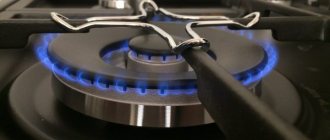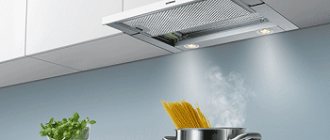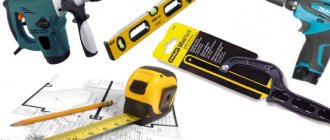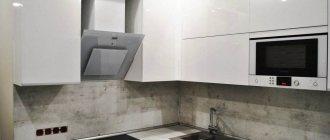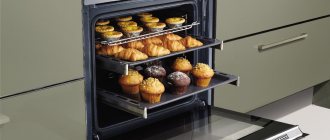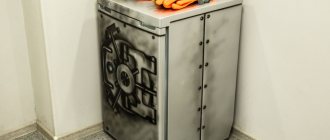According to the principle of operation, all exhaust systems resemble a vacuum cleaner, but they face completely different tasks. The hood is designed to remove various particles that appear in the air during cooking, thereby extending the life of furniture and other accessories. How is this function implemented? Let's look at the hood design and its main components.
Why do you need a hood in the kitchen?
When cooking food, especially during frying, a lot of heat and pungent odors are released. Steam comes out, and smoke comes from the gas. This causes the ceiling to smoke and damage the kitchen wall or apron set. That is why a hood, which is a forced ventilation device, is necessary in this room.
The hood can fit perfectly into any interior
Its main advantages:
- it gets rid of pungent odors;
- quickly removes steam and smoke directly into the common house pipe;
- ensures the absence of traces of high humidity, as well as various other deposits on the walls and ceiling.
Disadvantages occur only in certain types of ventilation units; for example, a cheap hood may be too noisy. But this is also easy to come to terms with.
Types of recirculation exhaust systems for the kitchen
Until now, we have divided devices for combating odors after cooking into charcoal and flow-through ones. Today we’ll look at how, in turn, the first options are divided into types. In addition, duct hoods differ in the number of technical characteristics, design, as well as the number of installed cleaning stages and filters. In addition, these devices are built-in and inclined.
- The good thing about the built-in model of a coal hood is that the entire unit, in which the working mechanism is hidden, is placed directly in the kitchen furniture, thereby not degrading the kitchen space with completely unnecessary details.
- Wall-mounted units are not designed to be installed in cabinets, so they can only be wall-mounted and are a significant size unit. However, there are also compact hoods, which are often purchased for small kitchens.
Don’t buy into the luxury of a model with a carbon hood, carefully study the range, because little-known brands can be just as good.
STORY!
We advise you to look for models with low noise levels as they can operate while you are cooking or while you are in the kitchen, providing a quieter environment.
Mechanical controls for hoods are divided into push-button and slider controls. You decide for yourself what is more convenient for you.
Calculation of a kitchen hood
But before choosing the type of exhaust system suitable for the given conditions, it is necessary to make an approximate calculation of the volume of removal of contaminated air.
Calculations are made primarily based on the size of the kitchen. The calculation of the electrical part is carried out according to the existing model of the hood.
Suppose the dimensions of the kitchen are 3 m x 4 m. Thus, the area of the room in this example is S = 12 m2. If the height of the walls is 2.5 m, then the volume of the kitchen will be V = 12 x 2.5 = 30 m3.
The performance of the hood (how many cubic meters per hour) is calculated as the product of the size of the room by the coefficient K. For electric stoves, K is approximately equal to 12 units, and for gas stoves - 20. It indicates the number of complete air changes in the entire room per hour.
In our case, we will use a gas stove. We get the following extraction capacity: P = 30 x 20 = 600 cubic meters per hour.
For a unit of this size, as practice shows, you will need a fan with a power of no more than 1 kW. When calculating electrical wiring, we will take this characteristic into account.
For a power of 1 kW, according to standard design standards for electrical conductors, a wire cross-section of 2.5 mm2 is sufficient. This parameter is used in lines in apartments. Therefore, any nearest outlet in the kitchen is suitable for installation.
The cross-sectional area of the air ducts is taken according to the following rules:
- It should be no smaller than the outlet of the hood.
- The cross-section of the air duct should be no larger than the area of the opening of the common house duct.
When installing a ventilation pipeline, you need to remember one more golden rule: the fewer bends in the line, the better the performance.
Grounding for the hood is not required.
Often in new buildings, a special two-wire wire is already installed in the kitchen specifically for the hood. Typically, in an apartment of a newly built house, this cable sticks out of the wall directly under the ventilation duct opening at a height of about a meter above the intended surface of the slab.
After calculations, you need to select the type of hood.
Options for selecting a kitchen hood
Installing exhaust equipment in the kitchen is a necessary and moderately difficult task. Before buying an air purifier, familiarize yourself with the basic criteria for choosing a model; you need to know how the hood works. The design of the hood plays an important role:
- air purifier operating mechanism;
- type of hood installation;
- hood size parameters;
- efficiency of the hood;
- the material from which the hood is made;
- noise level of the hood.
Everything is already clear about the operating principle of a kitchen hood. Let's look at other parameters in more detail.
Types of kitchen hoods
The different needs of users force manufacturers to develop offers that would optimally suit the needs of a specific buyer. Therefore, the range of kitchen hoods that the modern market of household appliances offers us is quite wide. Let's try to understand their diversity.
According to the method of purifying air masses
There are many ways to purify the air in the kitchen.
Depending on which of them is used in a particular model, hoods are divided into:
- Evacuees. These models exhaust air from the kitchen outside through air ducts made in the form of a metal box or corrugated pipe. For such a device to work, there must be a ventilation duct or a simple hole. Usually the air duct is equipped with a valve that prevents the occurrence of reverse draft.
- Circulating. This model has a carbon filter, similar to a gas mask. In fact, this is not a hood, but a filtering unit that purifies the air from the main “odors”: there is no air exchange with the external environment. Such a device is attractive due to its simplicity of installation, but it is not able to protect, for example, from gas leaks.
Circulating hoods can be adjacent to standard kitchen ventilation. Their disadvantages usually include high cost and expensive maintenance: carbon filters require periodic replacement.
The circulation model of a kitchen hood will not help you if carbon dioxide or carbon monoxide has accumulated in the room, and an evacuating model can easily cope with this problem
A special feature of an evacuating hood is that it also removes excess heat, which always forms during the cooking period. The circulation model does not have such a function.
Division by type of construction
In addition to the main function, buyers pay attention to other distinctive characteristics of various models. The exhaust device should fit well into the overall interior of the room, be convenient to use, and also: it would be nice if you could save money and install it yourself.
Therefore, modern hoods differ not only in their air purification power, but also in their installation method, design, material of manufacture and the presence of additional options.
A fireplace or dome hood is often found in our homes: it is important that the area of the lower part of its dome matches the area of the stove installed in the room
According to the type of design, exhaust devices are divided into:
- Dome. This model got its name due to the shape of the air intake. It looks like a truncated pyramid, the dome of which is located directly above the slab. An air duct extends from an opening in the top of the dome, transporting air outside the kitchen through a hole in the wall or through a ventilation duct.
- Built-in. This hood is located inside the furniture in the kitchen. Quite often, a built-in hood is equipped with a retractable panel, which allows for economical use of room space and, at the same time, provides comfortable control of the equipment.
Comparison of the best models of hoods with recirculation
The best models of kitchen hoods without a ventilation connection were evaluated based on key parameters:
- Hood type – an important parameter is the type of equipment, since different categories have certain prices (for example, devices built into a countertop are more affordable than full-fledged wall-mounted models).
- Noise level - 50-55 dB is considered an acceptable value; if this characteristic is exceeded, hood models are downgraded in class, since users will experience some discomfort during operation (motor noise can drown out conversations around the technician);
- The ratio of price, characteristics and performance - for each price category certain characteristics are important (availability of speeds, type of light bulbs, etc.); the volume of air that is recirculated per hour of operation is also taken into account;
Jet Air Anny SL 50 received high marks from users and experts. The sound produced by this model is one of the lowest among all hoods of this type (less than 40 dB). During operation, the fans and motor are practically inaudible. The carbon filter works efficiently and does not require replacement more than once every six months. This model is easy to mount on the wall. The metal body is available in several colors: white, gray or black. This design allows Jet Air Anna SL 50 to match modern and even classic kitchen styles. Mechanical hood and lighting speed controllers are reliable and durable. This is good value for money for kitchens up to 20 square meters.
Maunfeld Crosby Push 50 – the main advantage of this model over the Jet Air Anna SL 50 and others is its high performance (output of more than 700 cubic meters of air per hour). Affordability is another key factor when choosing. The non-vented Maunfeld Crosby Push 50 can be purchased for just $120. Pay attention to the modern design, which, combined with favorable power characteristics and a low price, makes this hood relevant.
Bosch DWP64CC60Z is a German-made hood, very similar to the Jet Air Anna SL 50. The ratio of affordable price and quality power indicators is liked by many connoisseurs of reasonable savings. There are no touch buttons or other innovations here. Unlike the Maunfeld Crosby Push 50, only stainless steel is used to make the case. German production guarantees quality and long service life.
Hotpoint-Ariston HKT 4 X is a custom option that falls into the island category. The ability not to connect such devices to the ventilation duct increases the convenience and practicality of its operation. The conical stainless steel case is an unconventional but modern solution. It is considered the best option in the category of kitchen island ventilation devices.
| Model | Rating | Price | Advantage |
| Hotpoint-Ariston HKT 4 X | 5 | 200 USD | Appearance |
| Bosch DWP64CC60Z | 5 | US$150 | Reliability |
| Maunfeld Crosby 50 | 5 | USD 120 | Appearance, strength |
| Jet Air Anny SL 50 | 5 | Up to 200 US dollars | Power, low noise |
| Hotpoint-Ariston HB 60 EIX | 2 | US$300 | Not available |
| Hotpoint-Ariston AH 60 CM X | 3 | 100 US dollars | Not available |
| Jet Air Ariel A/60 | 4 | 200-220 US dollars | Appearance, strength |
| Maunfeld Irwell G 50 | 4 | 150 USD | Appearance |
| Maunfeld Tower G Satin 60 Stripes | 4 | 120 US | Power, low price |
| Bosch DWA06E661 | 4 | 300 US | Reliability, power |
| Bosch DFL064W51 | 3 | US$120 | Reliability |
| Jet Air Molly P 60 INX | 3 | 200-220 US dollars | Appearance |
Which duct hood will you choose?
- Jet Air Molly P 60 INX
- Bosch DWP64CC60Z
- Hotpoint-Ariston AH 60 CM X
- Hotpoint-Ariston HKT 4 X
- Bosch DWA06E661
- Jet Air Anny SL 50
- Maunfeld Tower G Satin 60 Stripes
- Maunfeld Irwell G 50
- Hotpoint-Ariston HB 60 EIX
- Jet Air Ariel A/60
- Maunfeld Crosby 50
Natural and forced ventilation
SNiP establish the following standards for kitchen ventilation systems:
- The air exchange volume for kitchens equipped with gas hobs must be at least 100 m³ per hour.
- For kitchens equipped with electric stoves, this figure is slightly lower - 60 m³ per hour.
There are two types of ventilation systems used to provide air ventilation in kitchens - natural and forced.
Natural and forced ventilation
Natural ventilation
Natural ventilation systems operate on the principle of pressure differences between indoors and outdoors. In this case, no mechanical devices, such as fans, are used to create air flow. Air contaminated with harmful gases is removed from the room through ventilation shafts, usually installed in the thickness of the walls during the construction of the house.
Attention! For natural ventilation to work effectively, the volumes of exhaust air must be equal to the volumes of supply air. Supply ventilation is responsible for the flow of fresh air into the premises.
There are two types of natural ventilation:
- Organized. Air enters through specially designed supply ventilation ducts and valves.
- Disorganized. There are no special devices for air flow from outside. The influx occurs through leaks and microcracks in window frames and doors, walls and ceilings.
With the beginning of mass use of plastic windows and metal entrance doors equipped with sealing gaskets, problems with unorganized ventilation may arise. To ensure the flow of sufficient volumes of fresh air, it will be necessary to install recuperator valves mounted in walls or window frames.
The advantage of natural ventilation is its low cost and completely autonomous operation, independent of the availability of electricity or mechanical fans. The main disadvantage is the insufficient air exchange rate, which often does not meet the requirements of SNiP for kitchens.
Forced ventilation
Mechanical devices - fans - are used in forced ventilation. They are usually mounted on exhaust ducts, but additional installation of fans near the supply openings is possible. If the ventilation ducts are long, additional fans are installed inside the air ducts.
Wall Fan Design
An undoubted advantage of forced-type ventilation systems is their greater volume of work per unit of time than natural ventilation. Thanks to this, the minimum volumes of air exchange established by building regulations are easily ensured - up to 100 cubic meters. m per hour if there is a gas stove in the kitchen. The downside is the dependence on the availability of electricity and uninterrupted operation of fans.
Caring for the hood – what does it consist of?
For the hood to work correctly, it must be cleaned regularly. Before you start washing, you need to turn off the power to the device. Next, remove the filter and other removable parts and wash them.
You can use detergents and soft sponges to care for your hood. You should not use abrasive powders or steel wool - they can scratch the surface and ruin the appearance of the device.
At the final stage of cleaning, you need to wipe the device with a dry cloth, then connect it to the network - the hood is ready for use again.
In conclusion, I would like to say that it is difficult to overestimate the importance of the hood. This device is an indispensable attribute of a modern kitchen, with which it is easy to maintain cleanliness and hygiene in the room while cooking.
If you still have questions related to the design and functionality of kitchen hoods, ask them to the managers of our Vencon online store. Our specialists will help you understand the technical aspects that interest you.
Schematic diagram of a kitchen hood
Any hood includes the following elements:
- Fan with electric motor. A multi-speed asynchronous motor rotates the exhaust fan, which forces air flow through grease-retaining filters.
- Filters. All hoods are equipped with reusable or disposable grease filters. Carbon filters are present only in circulating models and act similarly to activated carbon. They are replaced every 3-4 months of operation.
- Lighting lamps. The hob is illuminated using incandescent, LED or halogen lighting fixtures.
- Speed switching diagram. In different models, speed switching is carried out in different ways: using touch devices, using buttons or using a slide switch.
Main components
Installing any class of hood in your kitchen is quite simple. In flow-through models, the lower part acts as a grease trap or coarse filter, the task of which is to retain fat particles and soot.
Modern models “hide” it behind a decorative cover.
Inside the air intake are fans driven by motors specially designed for hood use. With a direct-flow system, behind the fans there is an air duct connected to the building's ventilation system.
Coarse filter
In recirculating hoods, fine carbon filters are installed after the fan, the task of which is to remove unpleasant odors, because the air flow returns to the kitchen area. Coarse filters are made of durable aluminum and can be washed like greasy dishes. They are very light and not subject to corrosion. Carbon filters are inserted using a special cassette; they are very thin; they must be changed according to the recommendations in the instructions for each hood.
Carbon filter in the hood
The system body is made of thin metal or composite materials with noise reduction for new generation exhaust systems. There is practically no difference in performance, so each user chooses according to his own taste.
The operating principle of a standard kitchen hood is extremely simple:
- plug the power cord into the socket;
- press the key with the desired pulling force (indicated by dots or numbers from 1 to 3);
- the asynchronous motor is picking up speed, the ventilation is working.
If the home network is grounded, then good; otherwise, it is better to do it separately, because there is a gas pipe nearby.
Ensuring the safety of the structure
The exhaust equipment kit must include a fan, which means that the hood must be connected to an outlet. If you have just started renovations in a new apartment, be sure to provide a separate outlet for the hood, because this equipment must always be connected.
The occupancy of the outlet by a single device allows you to hide it behind the elements of the furniture set. But don't forget to make it easy to access. There is one more important rule: the socket should be located no closer than 60 cm from the sink and from the stove.
Remember that this hood is an electrical appliance that can cause electric shock, so electrical safety issues must be taken seriously.
The kitchen, like the bathroom, is a room that can be both hot and humid at the same time. Excess moisture and grease from cooking settles on the hood grate. This creates favorable conditions for electrical breakdown on the metal casing from the fan motor. It is for this reason that the device should be connected to the electrical network using three wires.
The connection diagram for the fan included in the kitchen hood clearly demonstrates that three wires are required: phase, neutral and ground.
The wiring must include zero, phase and ground. The ground wire can be easily identified by its yellow insulation and longitudinal green stripe. Modern houses are equipped in advance with European sockets and a grounding circuit. In this case, it is enough to connect the grounding wire to the corresponding terminal of the plug. It is easy to distinguish it from others by its icon in the form of three parallel lines of different sizes.
Older buildings may not have grounding loops. In this case, you need to take care of protection yourself. In the event of a breakdown on the housing, grounding will allow the circuit breaker to turn off. In addition, it is necessary for potential equalization.
As additional protection, it is recommended to make the wiring for the hood socket a separate cable with RCD and circuit breaker protection.
What kind of lighting is used in hoods
Almost all hoods are equipped with a lighting system. They usually have incandescent, halogen or LED lighting built into them. Such lamps are installed at the back wall (they are easiest to install there), which is why the distant burners are well illuminated, but not the nearest ones. However, in new models of hoods it is possible to adjust the intensity of the backlight, direct the lighting to the desired point or diffuse the light throughout the kitchen, and the lamps themselves can no longer be located at the rear edge of the hood, but along its perimeter or in the center.
Installation stages and types of kitchen hoods
All forced ventilation units for the kitchen are divided into two main classes.
- Open hoods, fully visible.
An open hood is installed between cabinets - Built into a closet, semi-hidden.
With built-in hoods, only the lower part is visible
Also among open devices there is a classification by location. Such hoods can be island or wall-mounted, and the latter can be corner.
Depending on the control method, the classification is as follows:
- remote (with remote control);
- push-button or touch.
How modern hoods work
This device operates on the principle of forced ventilation. It removes combustion products from the air, as well as unpleasant odors and fumes. The hood prevents grease from settling on the walls or cabinets with the ceiling, catches odors and any fumes, and the air in the apartment remains clean and fresh.
Inside the hood there is a system of special filters that capture fumes, odors and soot. In addition, it has a forced ventilation system. All this is enclosed in a housing on which there is a control panel, either electronic or mechanical.
electrical safety
The exhaust device belongs to the category of electrical devices that pose a risk of electric shock. As a result of the settling of fat and moisture in the mechanism, a breakdown of electricity from the fan motor to the metal frame is possible. In addition, the room itself is also dangerous due to elevated ambient temperatures and high humidity.
Let's figure out how to properly make a hood, fulfilling all electrical safety requirements.
Important: the product is connected to the network with 3 wires: phase-0-ground. Before installation, perform reliable grounding. To do this, connect to a dead neutral. Do not ground the hood to a drain or gas pipe.
The protective grounding process is performed as follows:
- Open the introductory panel in the house or entrance. This requires caution and attention, because the voltage is 220 V.
- The wires come out of a pipe built into the wall.
- Locate the threaded pin with the ground connections connected to it. This is a solid neutral, which is already grounded in a special place. Do not disconnect other ground connections - this is life-threatening.
- Throw the terminal up and tighten with the nut.
- Connect a 2.5 mm² wire to the device installation location.
- Connect the hood to the electrical network through a 6.3 A circuit breaker.
Wiring for equipment is laid depending on the design of the kitchen. If the connection is made automatically, it is mounted behind the wall cladding, in a PVC box, under the baseboard, and when plugged into a socket, behind the furniture.
If there are problems with conducting electricity to the hood, it is better to use the services of an electrician.
Exhaust equipment and its design
A household hood is a specialized device that cleans the air of impurities, smoke, and unpleasant odors released during the cooking of food. The design of this device consists of several parts, such as a housing, a ventilation unit, filters for trapping grease, and a control panel. Grease filters protect the motor and the internal surface of the equipment from the accumulation of fatty deposits.
All components of this equipment are made from materials resistant to rust and temperature changes. The body of the device is made of stainless steel as standard. A modern model, in addition to the function of air purification, can at the same time be a decoration for the kitchen, and also serves as a design object. Therefore, in addition to stainless steel, glass, wood, ceramics are used to make the body, and the hood is decorated with various decors.
Making a kitchen hood with your own hands
Before installing a hood in the kitchen, check the serviceability of the ventilation ducts in the house. If the ventilation is clogged or partially dirty, the traction force decreases and the hood does not work at full capacity. Therefore, first they clean the system and ensure air flow into the kitchen.
The devices are made of heat-resistant, corrosion-resistant and durable materials. Stainless steel is often used to make the case, then coated with enamel.
A simple and inexpensive way is to install the equipment in a cabinet above the hob. To do this, install a corrugated pipe and an electric fan inside. If there is no such cabinet, and the exhaust unit itself does not look aesthetically pleasing, the hood is made of plasterboard. The manufacturing process is labor-intensive and expensive, but the result is impressive.
From plasterboard
To make a kitchen hood with your own hands, you need to prepare the following tools and materials:
- Drywall.
- Galvanized metal profile.
- Corners.
- Corrugated pipe.
- Fastening elements.
- Paint, putty.
- Insulating material.
- Perforated
- Screwdriver.
- Scissors for cutting metal.
- Laser level or tape measure.
- Brushes, spatula.
The hood manufacturing process is carried out in several stages:
| Marking. | To do this, you need to determine the area where the ventilation hole will be located. If it is located away from the slab, the corrugated pipe is placed in a plasterboard box. |
| Creating a frame. | The frame for the hood has special features. The easiest way to place an air vent is in a straight line, without corners or deviations. Galvanized metal profiles are mounted to the wall using anchors along the entire perimeter. If the pipe runs with bends, first make markings on the ceiling, lay the first profile down in parts and secure it with self-tapping screws. Then install the second part and the transverse strips. The frame elements should be covered with plasterboard. |
| Manufacturing of the body. | A lower frame is made from the profile and secured. After this, parts of the frame are cut out and connected to the base. To enhance rigidity, the sides are equipped with additional jumpers. |
| Connection to the ventilation system. | A hole is made in the air duct for the corrugation to exit and the presence of draft is checked. For silent operation, they are sheathed with insulating material. |
| Decorative finishing. | Corners are attached to the corners, after which drywall must be applied to all elements of the device, treated with putty and painted. |
How hoods differ by type of control
There is a control panel on the outer part of the hood body. It can be push-button, touch or slider type.
- Touch control is convenient because you just need to touch the desired sector of the panel with your finger. The LED will immediately light up and the device will complete the task.
- The slider-type control panel allows you to select the desired mode using a mechanical slider that moves along the plane.
- Everything is simple with the buttons - each of them on the panel corresponds to one or another mode of the device.
Additionally, there may be a remote control, which is of course convenient, but the cost of these hoods is usually higher. The controls regulate the engine operating mode, performance, turning on and off the quartz or ultraviolet disinfection lamp, if provided, and turning on the backlight.
Correct connection of the air duct to the ventilation system
For this you will need:
- plastic air duct
- offset check valve
- tee splitter
In the end, you should end up with something like this.
How does it all work? When the hood is turned off, the valve will be open and warm air from the kitchen will quietly flow by gravity into the ventilation duct. As soon as you turn on the exhaust hood, the valve immediately closes automatically, blocking the air flow into the room.
In this case, all odors from the stove will easily go outside. When switched off, the pressure in the box drops and the valve automatically opens, connecting the ventilation shaft to the apartment.
Features of air duct installation
Correct selection of the hood, pipes, and connecting elements may not give the desired result if an error is made when installing the air duct to the ventilation shaft.
For high-quality operation of the exhaust equipment, you need to know how to connect the hood, and also take into account the following points:
- The piping assembly should be as straight as possible. Bends and deflections are not allowed. When using a corrugated air duct, you need to stretch it.
- It is necessary to use sealant to seal connections with pipes and adapters.
- In places where the duct bends, the diameter should exceed the cross-section of the corrugation itself. If this requirement is violated, the pressure will decrease, and hence the quality of operation of the entire exhaust system.
- A pipeline 3 meters long will effectively perform its functions - no more, without turns or bends. If a turn is necessary, its angle must be obtuse.
- When laying through a wall, adapters must be used to protect the pipeline from damage.
- Long corrugated pipes should be fixed every 1-1.5 m. This prevents them from bending and swaying when the hood is on.
- At the junction of the pipe being laid and the ventilation shaft, it is advisable to install a special lattice frame equipped with a check valve and a flange for fastening the edge of the air duct. The principle of operation is as follows - when the hood is turned off, air circulates freely through the grille, while the valve is open. When the device is turned on, the valve closes, preventing contaminated air from entering the room.
We recommend that you read: Ventilation ducts made of plastic pipes
You need to know that the throughput of the exhaust equipment drops by 10% with each turn of the pipeline at an acute or right angle. With several bends, the system is ineffective and operates with large overloads. If turns cannot be avoided, you should buy a device with more power, and also increase the nominal cross-section of the pipeline.
Assembly instructions - all numbers and performance
How does this all come together in practice? For capacities up to 300 m3/h (low speeds of most hoods), a d-125mm pipe is sufficient. On the device itself, the outlet hole may be larger.
For example, for 650 m3/h you will need a d-150mm pipe. However, you are unlikely to find such plastic pipes, and if you use the next standard size d-160mm, it will turn out to be a huge and awkward structure that spoils the entire interior and design of the kitchen.
Moreover, you will have to drill a factory hole for the ventilation duct in the wall, expanding it.
Therefore, in most cases, the optimal diameter of 125 mm is chosen. And you don’t need more.
The forced throughput capacity of standard channels and shafts with dimensions of 100*150mm is 400 m3/h.
An air flow of more than 450 m3/h simply will not fit there (it was tested in practice), even if it says 1200 m3/h on your hood!
Remember also that you cannot underestimate the diameter of the air duct too much compared to the outlet pipe on the hood. Otherwise, the vibration and noise will be so strong that the structure will have to be re-glued every month.
The connection of different diameters is made using special adapters.
Let's start assembling. First, install the adapter on the hood and connect the vertical section to it.
To improve its sound insulation, it makes sense to go crazy and stick a 5mm thick heat-sound-insulating material on top.
It wouldn’t hurt for them to cover the inside of the decorative casing and the noisiest part - the adapter. This is where the greatest turbulence occurs.
Next, add 90-degree elbows and other straight sections of duct as necessary to ultimately exit toward the hole in the wall.
All this is glued together with silicone, no superglues. There should be no gaps anywhere.
We reach the tee. A valve is installed in it from the side of the room.
Keep in mind that this is a gravity valve! It opens not due to air flow, but due to its weight.
One half of it is heavier than the other and at the same time it is installed at a slight angle of 2 degrees.
A few words about air ducts
The hood kit does not include an air duct. It will have to be purchased separately. It is believed that a metal box with a rectangular cross-section looks more aesthetically pleasing than aluminum corrugation, but it also has its advantages.
Anyone who thinks that corrugation does not look very attractive may be mistaken: under certain conditions, it can even decorate the interior of a room
The corrugation should be selected with a diameter that corresponds to the inlet hole in the upper part of the hood. If the length of this pipe is less than 1.5 meters, then the aerodynamic resistance of this material is practically negligible in comparison with the random losses resulting from turbulence in ventilation. The corrugation is easy to cut with ordinary scissors.
The corrugation can be given a square shape to connect it with the clapperboard. It completely lacks the resonant properties that sometimes occur with rigid boxes. If you still choose to purchase a corrugated stove, then cooking in your home will never be accompanied by a monotonous hum.
Preparing the ventilation shaft hole
Before all installation work, it is advisable to plaster the entry into the ventilation shaft itself and remove all sharp corners. This will give the entrance maximum aerodynamic qualities.
You should end up with approximately the same surface as a standard 90 degree round elbow.
It is recommended to add ceresit liquid (ceresit CT99) to the plaster solution.
This hole will be exposed to fat and moisture. And ceresite contains components that prevent the formation of mold.
However, do not use gypsum plaster under any circumstances. Its use in ventilation shafts is a direct path to the appearance of mold and fungi.
Attach sections of a standard air duct to the tee on both sides. From the side of the wall, 5-7 cm, wall it up in the ventilation duct. The exit itself is decorated with a square frame.
Types of installation of household exhaust devices
Air purifiers differ not only in operating principles, but also in types of installation.
- Flat hanging models. They are a canopy and are installed above the stove on the wall. A kitchen hood of this type is not always efficient enough, but has a varied design and small size.
- Ceiling air purifiers. They are attached to the ceiling. Island models are only suitable for large and spacious rooms.
- Built-in models. Mounted inside a cabinet hanging above the stove. The most compact type of hoods. They are closed with a cabinet, which allows you not to overpay for the design.
Each type has its own capabilities. Flat hanging models have an interesting design. Ceiling air purifiers are more powerful.
Technical characteristics overview
When purchasing a new hood or replacing an old one, you need to find out the features of specific models. Attention should be paid to both the structure and design, and most importantly, to the technical characteristics on which the efficiency of the ventilation equipment depends.
Device performance calculation
In order to correctly navigate the choice of an effective device, you need to know the exact area of the room. Typically, both the performance and the desired size of the kitchen are indicated in the technical data sheet of the product.
For example, Krona Camilla 600 has a capacity of 550 m³/h (in recirculation mode - 385 m³/h), so it is recommended for servicing rooms up to 11 m² (ceiling height 2.5-2.7 m).
If you use a less powerful installation for the same area, it simply will not cope with the task, and a more powerful hood will waste energy in vain
To calculate the performance yourself, you need to multiply the volume of the room by the number of recirculation cycles and take into account the error factor. For the kitchen, the minimum number of recirculation cycles is 12, KP is 1.3. Therefore, to find out the required performance, we consider:
11 x 2.5 x 12 x 1.3 = 429 m³/h
We can conclude that when using the Krona Camilla 600 hood, for sufficient air exchange over an area of 11 m², it is better to use the mode with exhaust ventilation, and use recirculation only as an additional function.
An error factor of 1.3 is usually used when calculating the performance of exhaust hoods; for recirculation models it is slightly higher - 1.7.
Is noise level that important?
The second important parameter that you need to pay attention to is the noise level. If the owners of an apartment or house spend a lot of time in the kitchen, it is advisable to keep it to a minimum. This point is also relevant for those who live in studios where the living room is combined with the kitchen.
Strong and sharp noises have a negative impact on human well-being, therefore increased demands are placed on household appliances equipped with fans and motors
Modern devices operate quite quietly, as they are equipped with special acoustic noise protection. In coal hoods, sounds can be made by a fan, a motor, and air moving inside the structure.
In devices with ventilation outlets, noise often appears due to improperly connected air outlet channels.
If you want the atmosphere in the kitchen to be comfortable during and after cooking, give preference to models with a noise level of 50-55 dB. The quietest devices operate in the range of 35-42 dB
The high cost of the model does not indicate that the hood will work quietly. On the contrary, expensive equipment is more productive than cheap equipment, so it is often devices with a high price tag that create a lot of background sounds - more than 60 dB. Let’s assume that the Neff D55ML66N0 model (36 thousand rubles) has a noise level of 72 dB, and the Elica Hidden HT (51.5 thousand rubles) has a noise level of 62 dB.
Convenient control and adjustment
You have to use the hood every day, so it is advisable to purchase a model with accessible, understandable and convenient controls. All control options can be divided into two large categories: manual and remote.
Manual (or mechanical) has varieties:
- slider (more and more rare);
- push-button (the most common type);
Expensive models are equipped with electronic control devices with touch contact panels for transmitting commands.
Models in the mid-price segment are designed traditionally: on the front panel there is a row of buttons with which you can set the desired mode (diversion or recirculation), change the speed, and turn on the backlight.
Modern programmable hoods have a number of useful additional delayed-action functions. For example, the interval ventilation mode will continue to clean the air even without your presence after certain periods of time.
For models with remote control, almost all adjustments are made from the remote control, but the front panel also has buttons or a touch screen for selecting the operating mode. The more convenient the method of operation, the more expensive the equipment.
Important Features and Options
In addition to the basic technical characteristics, there are a number of properties that can become very useful during operation. But if additional functions are not needed, you can save a lot on the purchase, since electronic filling, various modes, and programming increase the cost several times.
Image gallery
Photo from
Lighting – illumination of the work area
Operating modes – outlet and recirculation
Number of working speeds
Availability of filter contamination indicator
The competition of exhaust hoods in the household appliances market is intense, so manufacturers compete to invent new functions. For example, for some models you can regulate not only the intensity of air suction, but also the degree of illumination of the space, and also adjust the speed change in automatic mode.
Guidelines for choosing a hood without communication with ventilation are presented in the article, the contents of which we advise you to familiarize yourself with.

